您好,登錄后才能下訂單哦!
您好,登錄后才能下訂單哦!
這期內容當中小編將會給大家帶來有關如何正確的使用ElastchSearch,文章內容豐富且以專業的角度為大家分析和敘述,閱讀完這篇文章希望大家可以有所收獲。
首次添加文檔時,若索引不存在會自動創建; 借助 kibana 的dev-tools來實現 es 的交互
POST first-index/_doc
{
"@timestamp": "2021-03-31T01:12:00",
"message": "GET /search HTTP/1.1 200 1070000",
"user": {
"id": "YiHui",
"name": "一灰灰Blog"
},
"addr": {
"country": "cn",
"province": "hubei",
"city": "wuhan"
},
"age": 18
}
## 添加兩個數據進行測試
POST first-index/_doc
{
"@timestamp": "2021-03-31T02:12:00",
"message": "GET /search HTTP/1.1 200 1070000",
"user": {
"id": "ErHui",
"name": "二灰灰Blog"
},
"addr": {
"country": "cn",
"province": "hubei",
"city": "wuhan"
},
"age": 19
}當然也可以直接使用 http 進行交互,下面的方式和上面等價(后面都使用 kibanan 進行交互,更直觀一點)
curl -X POST 'http://localhost:9200/first-index/_doc?pretty' -H 'Content-Type: application/json' -d '
{
"@timestamp": "2021-03-31T01:12:00",
"message": "GET /search HTTP/1.1 200 1070000",
"user": {
"id": "YiHui",
"name": "一灰灰Blog"
},
"addr": {
"country": "cn",
"province": "hubei",
"city": "wuhan"
},
"age": 18
}'
除了基礎的查詢語法之外,直接使用 kibana 進行查詢,對于使用方而言,門檻最低;首先配置上面的 es 索引
Management -> Stack Management -> Kiabana Index Patterns
index pattern name
時間字段,選擇 @timestamp 這個與實際的文檔中的 field 有關



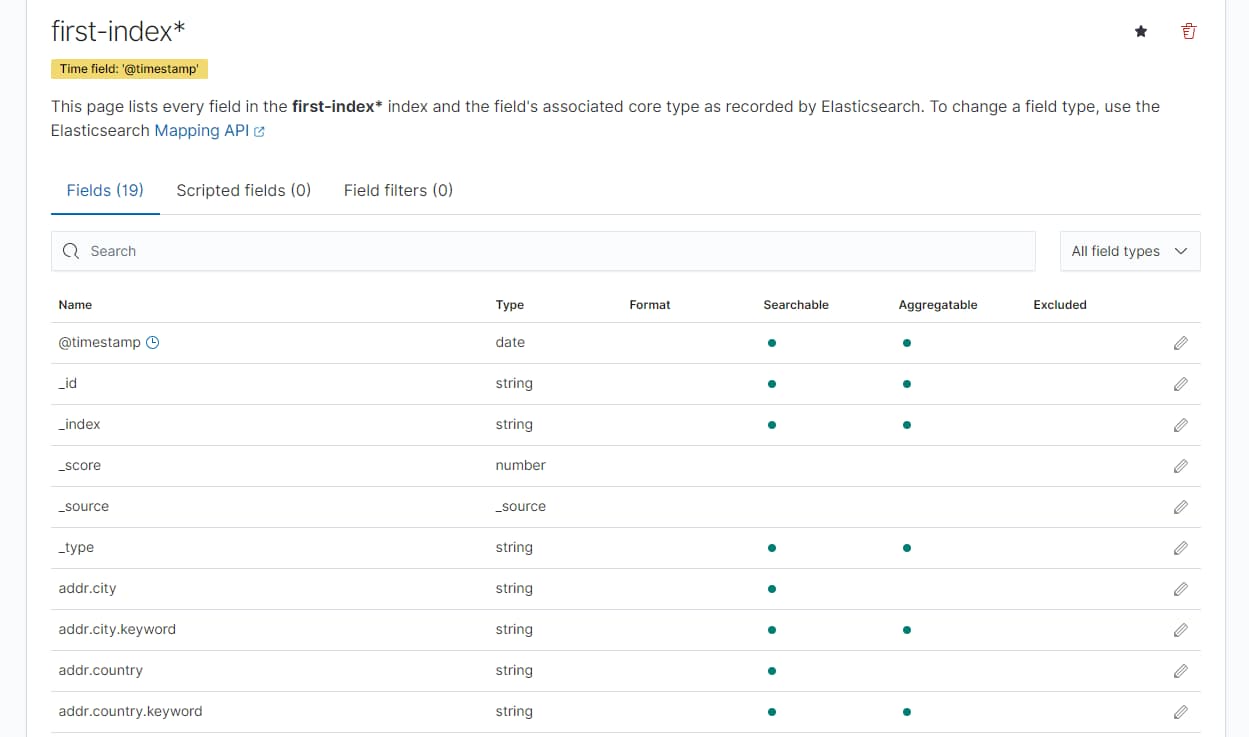
接下來進入Discover 進行查詢

比如字段查詢
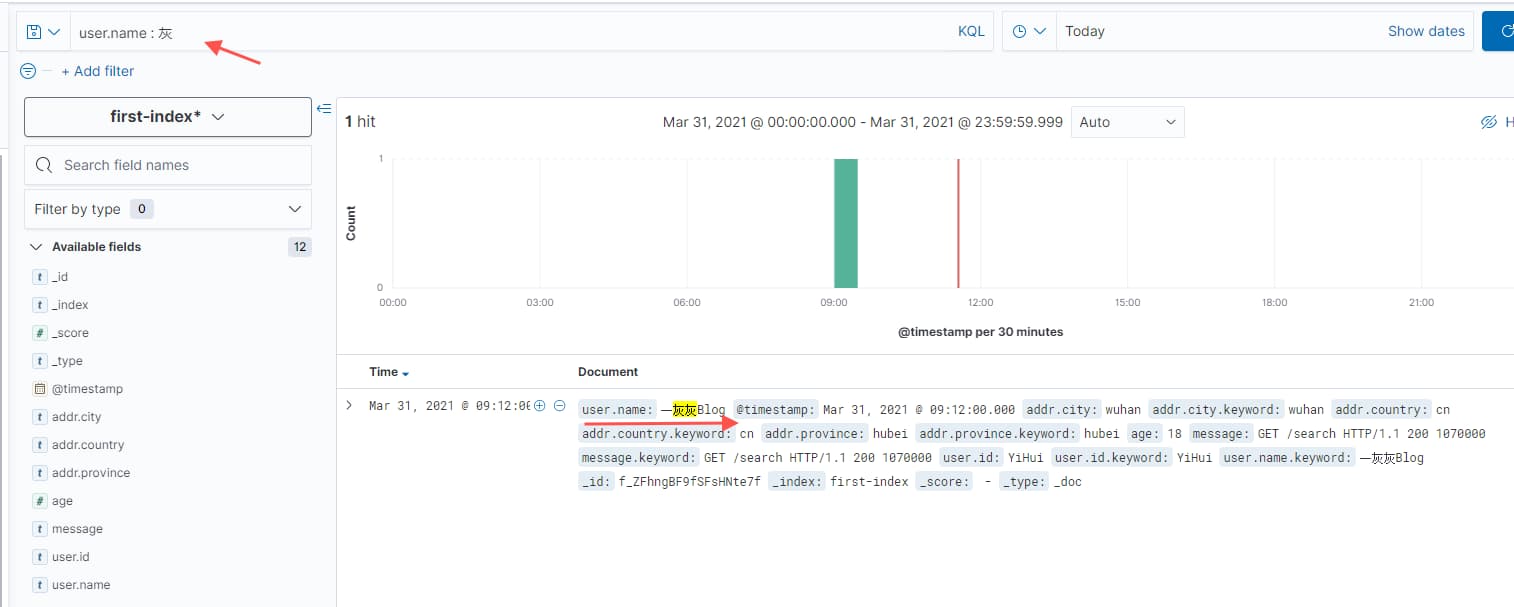
不加任何匹配,撈出文檔(當數據量很多時,當然也不會真的全部返回,也是會做分頁的)
GET my-index/_search
{
"query": {
"match_all": {
}
}
}
根據 field 進行 value 匹配,忽略大小寫;
查詢語法,形如: `{"query": {"term": {"成員名": {"value": "查詢值"}}}}
query, term, value 三個 key 為固定值
成員名: 為待查詢的成員
查詢值: 需要匹配的值
(說明:后面語法中,中文的都是需要替換的,英文的為固定值)
GET first-index/_search
{
"query": {
"term": {
"user.id": {
"value": "yihui"
}
}
}
}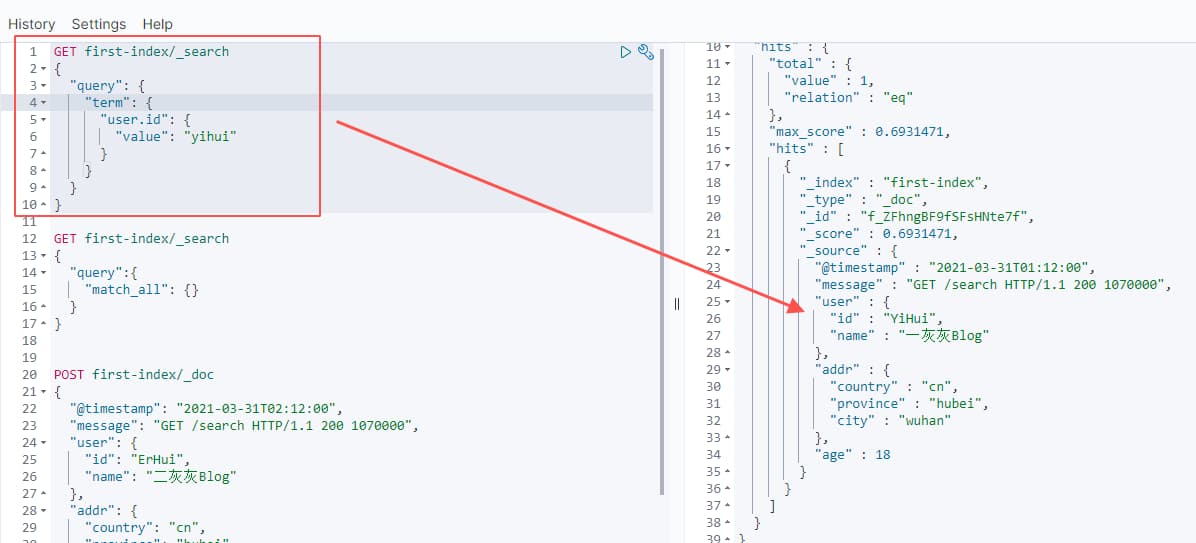
當 value 不匹配,或者查詢的 field 不存在,則查不到的對應的信息,如
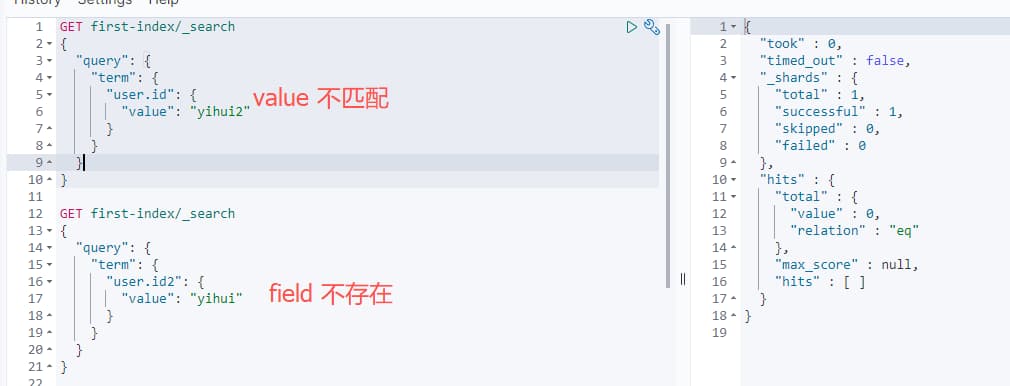
term 表示 value 的精確匹配,如果我希望類似value in (xxx)的查詢,則可以使用 terms
語法:
{
"query": {
"terms": {
"成員名": [成員值, 成員值]
}
}
}實例如
GET first-index/_search
{
"query": {
"terms": {
"user.id": ["yihui", "erhui"]
}
}
}
適用于數值、日期的比較查詢,如常見的 >, >=, <, <=
查詢語法
{
"query": {
"range": {
"成員名": {
"gte": "查詢下界" ,
"lte": "查詢下界"
}
}
}
}| 范圍操作符 | 說明 |
|---|---|
gt | 大于 > |
gte | 大于等于 >= |
lt | 小于 < |
lte | 小于等于 <= |
實例如下
GET first-index/_search
{
"query": {
"range": {
"age": {
"gte": 10,
"lte": 18
}
}
}
}
根據是否包含某個字段來查詢, 主要有兩個 exists 表示要求存在, missing表示要求不存在
查詢語法
{
"query": {
"exists/missing": {
"field": "字段值"
}
}
}實例如下
GET first-index/_search
{
"query": {
"exists": {
"field": "age"
}
}
}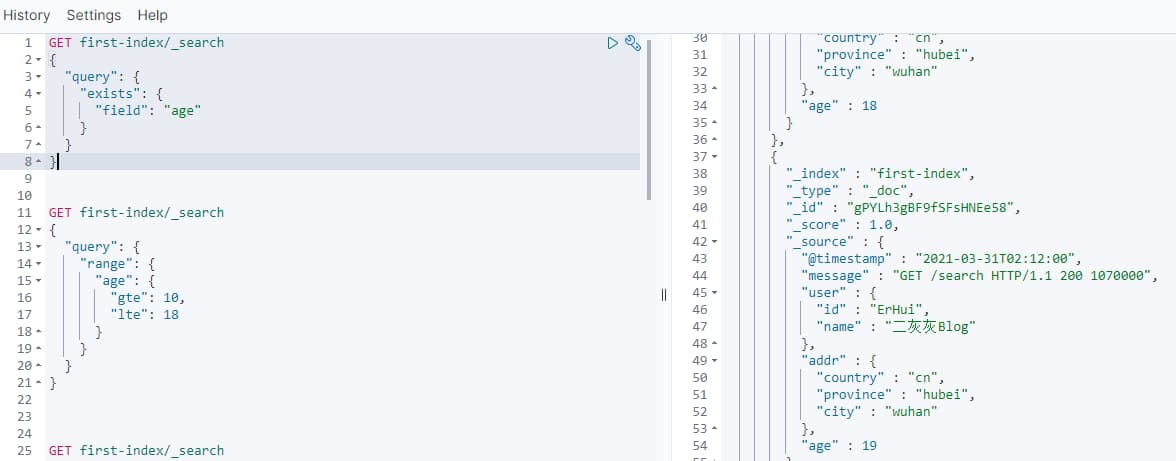
上面都是單個查詢條件,單我們需要多個查詢條件組合使用時,可以使用bool + must/must_not/should來實現
查詢語法
{
"query": {
"bool": {
"must": [ # 相當于and查詢
"查詢條件1",
"查詢條件2"
],
"must_not": [ # 多個查詢條件相反匹配,相當與not
...
],
"should": [ # 有一個匹配即可, 相當于or
...
]
}
}
}實例如下
## user.id = yihui and age < 20
GET first-index/_search
{
"query": {
"bool": {
"must": [
{
"term": {
"user.id": {
"value": "yihui"
}
}
},
{
"range": {
"age": {
"lt": 20
}
}
}
]
}
}
}
# !(user.id) = yihui and !(age>20)
GET first-index/_search
{
"query": {
"bool": {
"must_not": [
{
"term": {
"user.id": {
"value": "yihui"
}
}
},
{
"range": {
"age": {
"gt": 20
}
}
}
]
}
}
}
# user.id = 'yihui' or age>20
GET first-index/_search
{
"query": {
"bool": {
"should": [
{
"term": {
"user.id": {
"value": "yihui"
}
}
},
{
"range": {
"age": {
"gt": 20
}
}
}
]
}
}
}下面截圖以 must_not 輸出示意

說明
前面根據字段查詢 existing 只能單個匹配,可以借助這里的組合來實現多個的判斷
最大的特點是它更適用于模糊查詢,比如查詢某個 field 中的字段匹配
語法
{
"query": {
"match": {
"字段名": "查詢值"
}
}
}舉例說明
GET first-index/_search
{
"query": {
"match": {
"user.name": "灰og"
}
}
}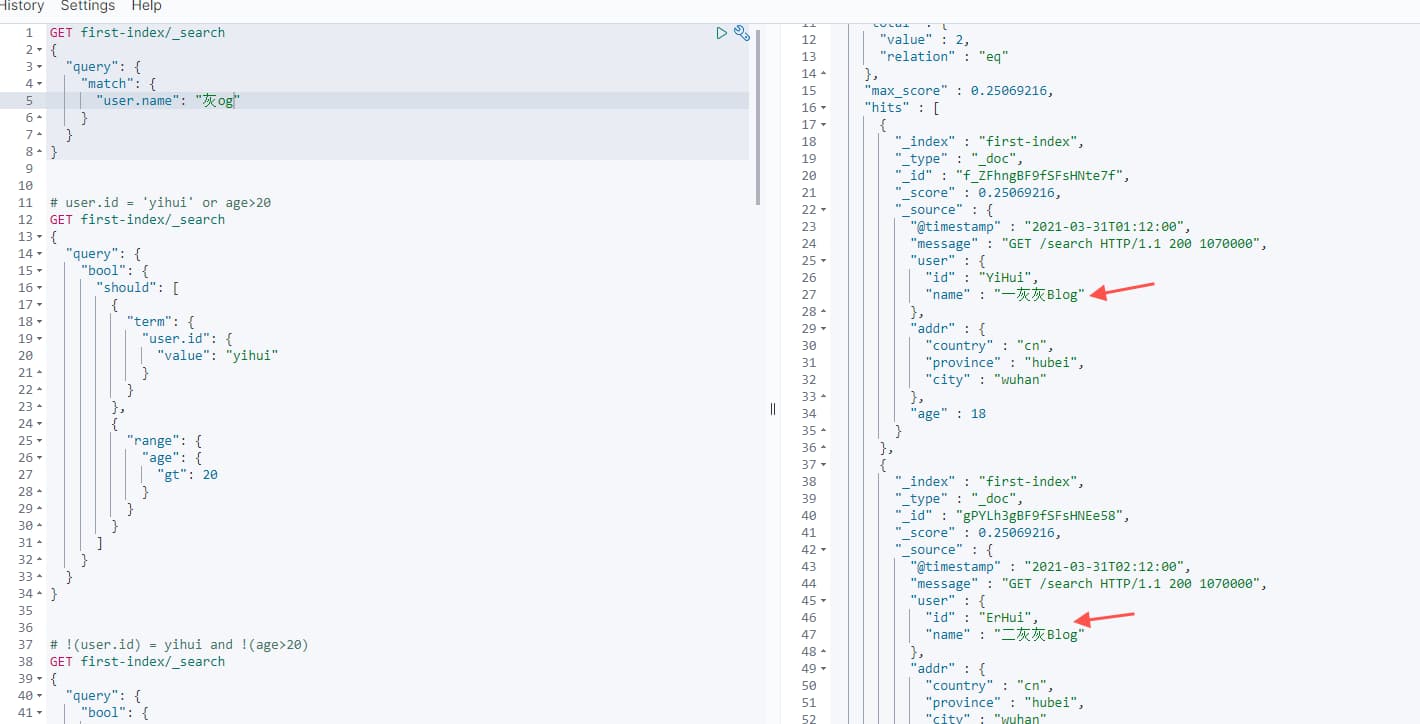
說明,如果有精確查詢的需求,使用前面的 term,可以緩存結果
更多相關信息,可以查看: 官網-multi_match 查詢
多個字段中進行查詢
語法
type: best_fields 、 most_fields 和 cross_fields (最佳字段、多數字段、跨字段)
最佳字段 :當搜索詞語具體概念的時候,比如 “brown fox” ,詞組比各自獨立的單詞更有意義
多數字段:為了對相關度進行微調,常用的一個技術就是將相同的數據索引到不同的字段,它們各自具有獨立的分析鏈。
混合字段:對于某些實體,我們需要在多個字段中確定其信息,單個字段都只能作為整體的一部分
{
"query": {
"multi_match": {
"query": "Quick brown fox",
"type": "best_fields",
"fields": [ "title", "body" ],
"tie_breaker": 0.3,
"minimum_should_match": "30%"
}
}
}實例演示
GET first-index/_search
{
"query": {
"multi_match": {
"query": "漢",
"fields": ["user.id", "addr.city"]
}
}
}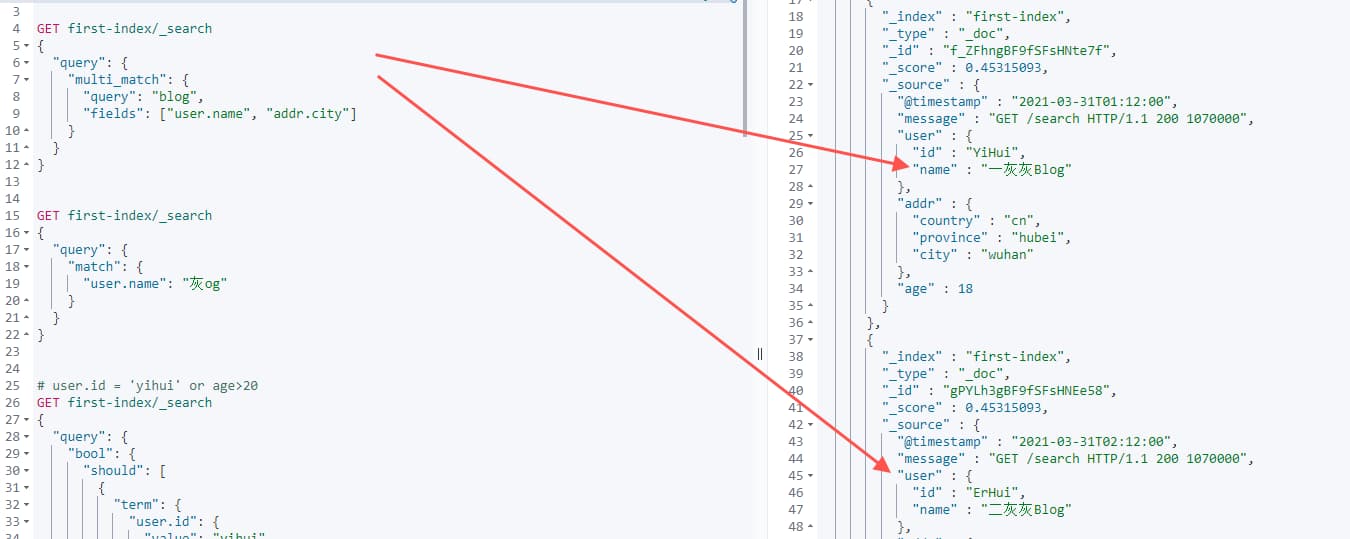
上面除了寫上精確的字段之外,還支持模糊匹配,比如所有字段中進行匹配
GET first-index/_search
{
"query": {
"multi_match": {
"query": "blog",
"fields": ["*"]
}
}
}shell 統配符
?: 0/1 個字符
*: 0/n 個字符
GET first-index/_search
{
"query": {
"wildcard": {
"user.id": {
"value": "*Hu?"
}
}
}
}說明,對中文可能有問題
正則匹配
GET first-index/_search
{
"query": {
"regexp": {
"user.name": ".*log"
}
}
}前綴匹配
GET first-index/_search
{
"query": {
"prefix": {
"user.name": "一"
}
}
}查詢結果排序,根據 sort 來指定
{
"sort": [
{
"成員變量": {
"order": "desc"
}
}
]
}實例如下
GET first-index/_search
{
"query":{
"match_all": {}
},
"sort": [
{
"@timestamp": {
"order": "desc"
}
}
]
}更多操作姿勢,可以在官方文檔上獲取
官方教程
需要根據文檔 id 進行指定刪除
DELETE first-index/_doc/gPYLh4gBF9fSFsHNEe58
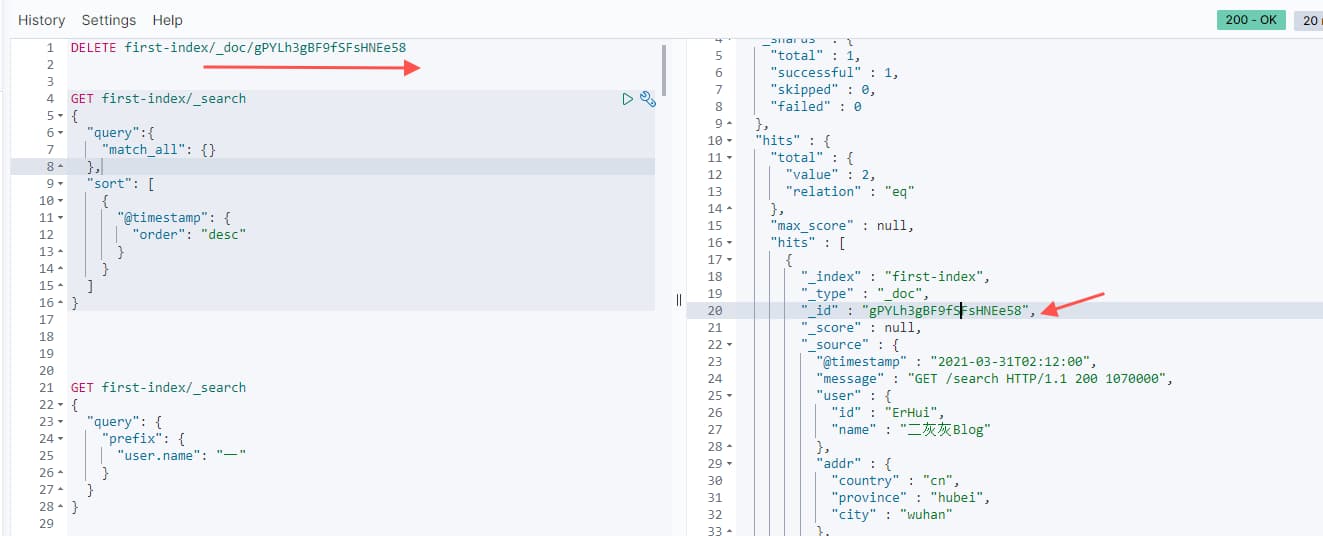
刪除成功

使用 PUT 來實現更新,同樣通過 id 進行
覆蓋更新
version 版本會+1
如果 id 對應的文檔不存在,則新增
PUT first-index/_doc/f_ZFhngBF9fSFsHNte7f
{
"age": 28
}
采用 POST 來實現增量更新
field 存在,則更新
field 不存在,則新增
POST first-index/_update/gvarh4gBF9fSFsHNuO49
{
"doc": {
"age": 25
}
}
此外還可以采用 script 腳本更新
在原來的 age 基礎上 + 5
POST first-index/_update/gvarh4gBF9fSFsHNuO49
{
"script": "ctx._source.age += 5"
}上述就是小編為大家分享的如何正確的使用ElastchSearch了,如果剛好有類似的疑惑,不妨參照上述分析進行理解。如果想知道更多相關知識,歡迎關注億速云行業資訊頻道。
免責聲明:本站發布的內容(圖片、視頻和文字)以原創、轉載和分享為主,文章觀點不代表本網站立場,如果涉及侵權請聯系站長郵箱:is@yisu.com進行舉報,并提供相關證據,一經查實,將立刻刪除涉嫌侵權內容。